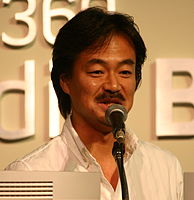Mario theme by Sim24
Download: Mario_2.p3t
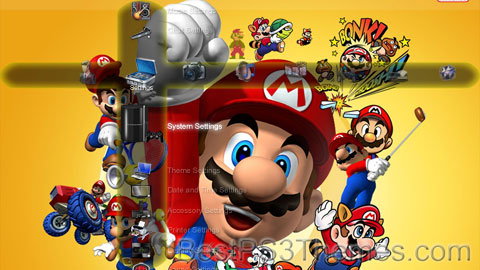
(1 background)
| Mario | |
|---|---|
| Mario character | |
 Mario, as depicted in New Super Mario Bros. U Deluxe | |
| First appearance | Donkey Kong (1981) |
| Created by | Shigeru Miyamoto |
| Designed by |
|
| Voiced by | Charles Martinet (1991–2023) Kevin Afghani (2023–present) Others:
|
| Portrayed by |
|
| In-universe information | |
| Family | Luigi (brother) |
| Nationality | Italian (games)[22] Italian American (other media) |
Mario (/mɑːrioʊ/, /mærioʊ/) is a character from the Mario franchise and the mascot of Japanese video game company Nintendo. Created by video game designer Shigeru Miyamoto, Mario is an Italian plumber who resides in the Mushroom Kingdom with his younger twin brother, Luigi. Their adventures generally involve rescuing Princess Peach from the villain Bowser while using power-ups that give them different abilities.[23][24]
Mario first appeared as the player character of the 1981 platformer game Donkey Kong. Originally Miyamoto wanted to use Popeye as the protagonist, but was unable to acquire the licensing rights, leading him to create Mario.[25] Many elements of Mario's design were due to the graphical limitations of arcade hardware, such as a large nose, a mustache to accentuate his nose, and overalls to make his arms more identifiable.[26] Originally called "Mr. Video" and "Jumpman", he was renamed Mario after Nintendo of America's landlord, Mario Segale. Following his appearance in Donkey Kong, he would make cameo appearances in other video games before making his appearance in Super Mario Bros. (1985), a Nintendo Entertainment System game that started the Super Mario series. Charles Martinet voiced Mario from 1991 to 2023, before being succeeded by Kevin Afghani.
After Super Mario Bros., Mario began to branch off into different genres and has appeared in over 200 video games since his creation. These include puzzle games such as Dr. Mario, role-playing games such as Paper Mario and Mario & Luigi, and sports games such as Mario Kart and Mario Tennis. He has appeared in other Nintendo properties, such as in the Super Smash Bros. series of crossover fighting games. Mario has also appeared in animated media, including three series produced by DIC Entertainment (voiced by Lou Albano and later Walker Boone). He was portrayed by Bob Hoskins in the live-action Super Mario Bros. film in 1993 and voiced by Chris Pratt in The Super Mario Bros. Movie in 2023.
An established pop culture icon, Mario holds multiple Guinness World Records titles, such as "Most Prolific Video Game Character", "Longest-running Computer Game Character", and "Godfather of gaming". He has appeared in a variety of merchandise, such as clothing and collectible items, and people and places have been nicknamed after him. He has inspired a considerable amount of unofficial media.
Concept and creation[edit]

Shigeru Miyamoto created Mario while developing Donkey Kong in an attempt to produce a successful video game for Nintendo; previous games, such as Sheriff, had not achieved the success of games such as Namco's Pac-Man.[27] Originally, Miyamoto wanted to create a game that used the 1930s characters Popeye, Bluto, and Olive Oyl.[28][29] At the time, however, as Miyamoto was unable to acquire a license to use the characters (and would not until 1982 with Popeye), he ended up creating an unnamed player character, along with Donkey Kong and Lady (later known as Pauline).[28]
In the early stages of Donkey Kong, Mario was drawn using pixel dots in a 16x16 grid.[30] The focus of the game was to escape a maze, while Mario did not have the ability to jump. However, Miyamoto soon introduced jumping capabilities for the player character, reasoning that "If you had a barrel rolling towards you, what would you do?"[31][27] Continuing to draw from 1930s media, King Kong served as an inspiration, and Mario was set in New York City.[32][33][34]
Name[edit]
Though the protagonist was unnamed in the Japanese release of Donkey Kong, he was named "Jumpman" in the game's English instructions[35] and "little Mario" in the sales brochure.[36] Miyamoto envisioned a "go-to" character he could use in any game he developed if needed, albeit in cameo appearances as Miyamoto did not, at the time, expect the character to become singularly popular.[37] To this end, he originally named the character "Mr. Video", comparing what he intended for the character's appearances in later games to the cameos that Alfred Hitchcock had done within his films.[38] In retrospect, Miyamoto commented that if he had named Mario "Mr. Video", Mario likely would have "disappeared off the face of the Earth."[38]

According to a widely circulated story, during the localization of Donkey Kong for American audiences, Nintendo of America's warehouse landlord, Mario Segale, confronted then-president Minoru Arakawa, demanding back rent. Following a heated argument in which the Nintendo employees eventually convinced Segale he would be paid, they opted to name the character in the game Mario after him.[39][40] A friend of Mario Segale commented: "My direct understanding and perception is that Mario Segale doesn't mind at all the fact that his name inspired such an iconic character, and that he shows humble pride in that fact in front of his grandchildren and close-knit adult circles."[41]
While it is implied by the title of the Mario Bros. series, in a 1989 interview, his full name was stated not to be "Mario Mario".[42] The first notable use of "Mario Mario" was in the 1993 live-action film adaptation of the Super Mario series, and was further used in Prima's official video game strategy guides, in 2000 for Mario Party 2[43] and in 2003 for Mario & Luigi: Superstar Saga.[44] In 2012, after Mario voice actor Charles Martinet stated that the character's name was, in fact, "Mario Mario" at the San Diego Comic-Con,[45] Nintendo CEO Satoru Iwata said Mario had no last name,[46] with which Miyamoto agreed the month after.[47] Two months after Iwata's death in July 2015, Miyamoto changed his stance, asserting at the Super Mario Bros. 30th Anniversary festival that Mario's full name was indeed "Mario Mario".[48][49] Mario can also be referred to as "Super Mario" when he acquires the Super Mushroom power-up.[50]
Appearance and profession[edit]
By Miyamoto's own account, Mario's profession was chosen to fit with the game design: since Donkey Kong takes place on a construction site, Mario was made into a carpenter; and when he appeared again in Mario Bros., it was decided that he should be a plumber, because a lot of the game is situated in underground settings.[22] Mario's character design, particularly his large nose, draws on Western influences; once he became a plumber, Miyamoto decided to "put him in New York" and make him Italian,[22] light-heartedly attributing Mario's nationality to his mustache.[51] Other sources have Mario's profession chosen to be carpentry in an effort to depict the character as an ordinary hard worker, making it easier for players to identify with him.[52] After a colleague suggested that Mario more closely resembled a plumber, Miyamoto changed Mario's profession accordingly and developed Mario Bros.,[28] featuring the character in the sewers of New York City.[53]
Due to the graphical limitations of arcade hardware at the time, Miyamoto clothed the character in red overalls and a blue shirt to contrast against each other and the background, making the movements of his arms easily perceptible.[54] A red cap was added to let Miyamoto avoid drawing the character's hairstyle, forehead, and eyebrows, as well as to circumvent the issue of animating his hair as he jumped.[28][22] To give distinctly human facial features with the limited graphical abilities, Miyamoto drew a large nose and a mustache, which avoided the need to draw a mouth and facial expressions.[55] Omitting a mouth circumvented the problem of clearly separating the nose from the mouth with a limited number of pixels available.[54]
Over time, Mario's appearance has become more defined; blue eyes, white gloves, brown shoes, a red "M" in a white circle on the front of his hat and gold buttons on his overalls have been added. According to an interview, Japanese character designer Yōichi Kotabe, who worked on redesigning characters in Super Mario Bros. (1985), revealed that Mario's M on his hat was originally the resemblance of McDonald's logo; Kotabe later changed the design of M and straightened its lines to clearly distinguish the difference.[56] The colors of his shirt and overalls were also reversed from a blue shirt with red overalls to a red shirt with blue overalls. Miyamoto attributed this process to the different development teams and artists for each game as well as advances in technology.[52]
Voice acting[edit]

Mario was voiced by Charles Martinet from 1991 to 2023.[57][58] When he crashed the audition,[59] the directors were preparing to close for the night, already packing up when he arrived. He was prompted with "an Italian plumber from Brooklyn"; when he heard the phrase, he immediately thought of a stereotypical Italian accent with a voice similar to that of a mobster.[60] He then assumed the voice would be too harsh for children, so he planned on using a voice of an older figure.[60] However, according to Martinet, the audition for Mario was the only time where his thoughts crashed and he spoke complete nonsense. After he was prompted the character, he babbled the following in a soft and friendly voice instead:[61]
"Hello, ima Mario. Okey dokey, letsa make a pizza pie together, you go get somea spaghetti, you go geta some sausage, I getta some sauce, you gonna put some spaghetti on the sausage and the sausage on the pizza, then I'm gonna chasea you with the pizza, then you gonna chasea me with the pizza, and gonaa makea lasagne."[62]
The voice he chose was derived from another voice role he used to play the character Gremio from William Shakespeare's The Taming of the Shrew.[59][63] Martinet kept speaking with the voice until the audition tape ran out; the clip was the only tape sent back to Nintendo, and when the director called the company he said he "found our Mario".[57][64] For the following years he would use the voice for an attraction at trade shows: small tracking sensors were glued onto his face, and he would voice a 3D model of Mario's head on a television while he remained hidden behind a curtain. When attendees would approach the screen, they could talk and interact with Mario.[59][57][65] The attraction was successful and would be used for five years until he was called by Miyamoto, requesting that he use the voice for a video game.[59]
His first official video game voice role would be the CD rerelease of Mario Teaches Typing in 1994, but his first major voice acting role was Super Mario 64. He received instructions on the types of sound clips needed from Miyamoto, and Martinet appreciated the fun tone of the game and later called Miyamoto a genius.[60] He has since also continued to voice other various Mario characters, such as Luigi, Wario, and Waluigi.[60] His time in the studio recording voice clips consisted of "45 takes of every sound [he] can think of", according to Martinet at a Q&A in Canada.[66] What time he gives vocals for the game varies, and according to him has ranged from three years before a game's release to one week. The amount of clips varies as well, ranging from one hour of audio to 20.[63][67] Martinet was recognized by the Guinness World Records for the most roles performed with the same character, at the time one hundred, and is the most of any video game voice actor.[68] As of January 2022, he has voiced Mario in over 150 games and has recorded 5 million audio files with the voice.[63][66] In an interview, Martinet said he wants to continue voicing the character until he "drops dead", or until he can no longer perform the voice accurately.[66] In August 2023, Nintendo announced Martinet would be retiring from the voice role of Mario,[58] though he would continue to promote the franchise as a "Mario Ambassador". Voice actor Kevin Afghani succeeded Martinet in Super Mario Bros. Wonder the following October.[69][70]
Characteristics[edit]
Mario is depicted as a portly plumber who lives in the fictional land of the Mushroom Kingdom with Luigi, his younger, taller brother.[28][71][72] The original Mario Bros. depicted Mario and Luigi as Italians in New York,[22] with the television series and films specifying them as originating from the borough Brooklyn.[71] Mario's infancy, in which he was transported by a stork to the Mushroom Kingdom, was first depicted in Super Mario World 2: Yoshi's Island.[73][74] In a 2005 interview, Miyamoto stated that Mario's physical age was about 24–25 years old,[75][76] and Nintendo Power stated that his birthday is October 11.[77][78]
He wears a long-sleeved red shirt, a pair of blue overalls with yellow buttons, brown shoes, white gloves, and a red cap with a red "M" printed on a white circle. In Donkey Kong, he wore a pair of red overalls, and a blue shirt. In Super Mario Bros., he wore a brown shirt with red overalls. He has blue eyes, and, like Luigi, has brown hair, and a dark brown or black mustache. This consistent difference in color is attributed to being a relic from designing the characters for their original platforms, wherein certain features were actively distinguished while others had to be curtailed due to technical limitations.[79]
Mario's occupation is plumbing, though in the original Donkey Kong games he is a carpenter.[22] Mario has also assumed several other occupations: in the Dr. Mario series of puzzle games, which debuted in 1990, Mario is portrayed as a medical physician named "Dr. Mario";[80] in the Game Boy game Mario's Picross, Mario is an archaeologist;[81] in Mario vs. Donkey Kong 2: March of the Minis, Mario is the president of a profitable toy-making company.[82] Mario is an athlete in Mario sports games in games such as tennis and golf, as well as a kart racer in the Mario Kart series.[83] In September 2017, Nintendo confirmed on their official Japanese profile for the character that Mario was no longer considered a plumber,[84] but the statement was changed in March 2018.[85] Although according to Nintendo, Mario has seven careers, which include plumber, doctor, racer, martial artist, basketball player, baseball player, and soccer player.[86]
Nintendo's characterization of Mario as a Brooklynite Italian-American has been described as an example of mukokuseki, or "nationlessness", with "roots across [the] three continents" of Europe, North America, and Japan.[87]
Relationships[edit]
Mario usually saves Princess Peach and the Mushroom Kingdom and purges antagonists, such as Bowser, from various areas; since his first game, Mario has usually had the role of saving the damsel in distress.[71] Originally, he had to rescue his girlfriend Pauline in Donkey Kong (1981) from Donkey Kong.[88] Pauline was soon replaced by Princess Peach in Super Mario Bros.,[28] although Pauline has reappeared in the Mario vs. Donkey Kong series and is considered "Mario's friend" instead.[89] Mario reprises his role of saving Peach in the Super Mario series,[71] but Mario himself was rescued by Peach in role-reversal in Super Princess Peach.[90] Mario rescued Princess Daisy of Sarasaland in Super Mario Land,[91] but Luigi has since been more linked to her; in Super Smash Bros. Melee, the text explaining Daisy states that "After her appearance in Mario Golf, some gossips started portraying her as Luigi's answer to Mario's Peach."[92]
Luigi is Mario's younger fraternal twin brother, who is taller, slimmer, and can jump higher than him.[72][93] He is a companion in the Mario games,[72] and the character whom the second player controls in two-player sessions of many of the video games.[94] Luigi has also occasionally rescued Mario as seen in Mario Is Missing! and the Luigi's Mansion series.[95] Super Mario Land 2: 6 Golden Coins for the Game Boy saw the arrival of Wario, Mario's greedy counterpart and self-declared arch rival, who usually assumes the role of a main antagonist or an antihero.[96] The dinosaur character Yoshi serves as Mario's steed and sidekick in games such as Super Mario World.[97] Toad is Mario's trusted close friend, who gives him advice and supports him throughout his journey to rescue Princess Peach.[98]
Abilities[edit]
During the development of Donkey Kong, Mario was known as Jumpman (ジャンプマン, Janpuman).
Brake Time theme by Sim24 Download: BrakeTime.p3t P3T Unpacker v0.12 This program unpacks Playstation 3 Theme files (.p3t) so that you can touch-up an existing theme to your likings or use a certain wallpaper from it (as many themes have multiple). But remember, if you use content from another theme and release it, be sure to give credit! Download for Windows: p3textractor.zip Instructions: Download p3textractor.zip from above. Extract the files to a folder with a program such as WinZip or WinRAR. Now there are multiple ways to extract the theme. The first way is to simply open the p3t file with p3textractor.exe. If you don’t know how to do this, right click the p3t file and select Open With. Alternatively, open the p3t file and it will ask you to select a program to open with. Click Browse and find p3textractor.exe from where you previously extracted it to. It will open CMD and extract the theme to extracted.[filename]. After that, all you need to do for any future p3t files is open them and it will extract. The second way is very simple. Just drag the p3t file to p3textractor.exe. It will open CMD and extract the theme to extracted.[filename]. For the third way, first put the p3t file you want to extract into the same folder as p3textractor.exe. Open CMD and browse to the folder with p3extractor.exe. Enter the following: BloodSpillXXT – Shaiya – Light theme by BloodSpillXXT Download: BloodSpillXXTShaiyaLight.p3t P3T Unpacker v0.12 This program unpacks Playstation 3 Theme files (.p3t) so that you can touch-up an existing theme to your likings or use a certain wallpaper from it (as many themes have multiple). But remember, if you use content from another theme and release it, be sure to give credit! Download for Windows: p3textractor.zip Instructions: Download p3textractor.zip from above. Extract the files to a folder with a program such as WinZip or WinRAR. Now there are multiple ways to extract the theme. The first way is to simply open the p3t file with p3textractor.exe. If you don’t know how to do this, right click the p3t file and select Open With. Alternatively, open the p3t file and it will ask you to select a program to open with. Click Browse and find p3textractor.exe from where you previously extracted it to. It will open CMD and extract the theme to extracted.[filename]. After that, all you need to do for any future p3t files is open them and it will extract. The second way is very simple. Just drag the p3t file to p3textractor.exe. It will open CMD and extract the theme to extracted.[filename]. For the third way, first put the p3t file you want to extract into the same folder as p3textractor.exe. Open CMD and browse to the folder with p3extractor.exe. Enter the following: BloodSpillXXT – Shaiya – Darkness theme by BloodSpillXXT Download: BloodSpillXXTShaiyaDarkness.p3t P3T Unpacker v0.12 This program unpacks Playstation 3 Theme files (.p3t) so that you can touch-up an existing theme to your likings or use a certain wallpaper from it (as many themes have multiple). But remember, if you use content from another theme and release it, be sure to give credit! Download for Windows: p3textractor.zip Instructions: Download p3textractor.zip from above. Extract the files to a folder with a program such as WinZip or WinRAR. Now there are multiple ways to extract the theme. The first way is to simply open the p3t file with p3textractor.exe. If you don’t know how to do this, right click the p3t file and select Open With. Alternatively, open the p3t file and it will ask you to select a program to open with. Click Browse and find p3textractor.exe from where you previously extracted it to. It will open CMD and extract the theme to extracted.[filename]. After that, all you need to do for any future p3t files is open them and it will extract. The second way is very simple. Just drag the p3t file to p3textractor.exe. It will open CMD and extract the theme to extracted.[filename]. For the third way, first put the p3t file you want to extract into the same folder as p3textractor.exe. Open CMD and browse to the folder with p3extractor.exe. Enter the following: Take It Easy, Niko… theme by OPTIMUS Download: TakeItEasyNiko.p3t P3T Unpacker v0.12 This program unpacks Playstation 3 Theme files (.p3t) so that you can touch-up an existing theme to your likings or use a certain wallpaper from it (as many themes have multiple). But remember, if you use content from another theme and release it, be sure to give credit! Download for Windows: p3textractor.zip Instructions: Download p3textractor.zip from above. Extract the files to a folder with a program such as WinZip or WinRAR. Now there are multiple ways to extract the theme. The first way is to simply open the p3t file with p3textractor.exe. If you don’t know how to do this, right click the p3t file and select Open With. Alternatively, open the p3t file and it will ask you to select a program to open with. Click Browse and find p3textractor.exe from where you previously extracted it to. It will open CMD and extract the theme to extracted.[filename]. After that, all you need to do for any future p3t files is open them and it will extract. The second way is very simple. Just drag the p3t file to p3textractor.exe. It will open CMD and extract the theme to extracted.[filename]. For the third way, first put the p3t file you want to extract into the same folder as p3textractor.exe. Open CMD and browse to the folder with p3extractor.exe. Enter the following: Tiger theme by Yogosan Download: Tiger_3.p3t
The tiger (Panthera tigris) is a member of the genus Panthera and the largest living cat species native to Asia. It has a powerful, muscular body with a large head and paws, a long tail, and orange fur with black, mostly vertical stripes. It is traditionally classified into nine recent subspecies, though some recognise only two subspecies, mainland Asian tigers and island tigers of the Sunda Islands.
Throughout the tiger's range, it inhabits mainly forests, from coniferous and temperate broadleaf and mixed forests in the Russian Far East and Northeast China to tropical and subtropical moist broadleaf forests on the Indian subcontinent and Southeast Asia. The tiger is an apex predator and preys mainly on ungulates such as deer and wild boar, which it takes by ambush. It lives a mostly solitary life and occupies home ranges, which it defends from individuals of the same sex. The range of a male tiger overlaps with that of multiple females with whom he mates. Females give birth to usually two or three cubs that stay with their mother for about two years. When becoming independent, they leave their mother's home range and establish their own.
Since the early 20th century, tiger populations have lost at least 93% of their historic range and are locally extinct in West and Central Asia, in large areas of China, and on the islands of Java and Bali. Today, the tiger's range is severely fragmented. It is listed as Endangered on the IUCN Red List of Threatened Species, as its range is thought to have declined by 53% to 68% since the late 1990s. Major reasons for this decline are habitat destruction and fragmentation due to deforestation, poaching for fur, and the illegal trade of tiger body parts for medicinal purposes. Tigers are also victims of human–wildlife conflict as they attack and prey on livestock in areas where natural prey is scarce.
The tiger is legally protected in all range countries. National conservation measures consist of action plans, anti-poaching patrols and schemes for monitoring tiger populations. In several range countries, wildlife corridors have been established and tiger reintroduction is planned..
The tiger is among the most popular of the world's charismatic megafauna. It has been kept in captivity since ancient times and has been trained to perform in circuses and other entertainment shows. The tiger featured prominently in the ancient mythology and folklore of cultures throughout its historic range and has continued to appear in culture worldwide.
The Old English tigras derives from Old French tigre, from Latin tigris, which was a borrowing from Classical Greek τίγρις 'tigris'.[4]
Since ancient times, the word tigris has been suggested to originate from the Armenian or Persian word for 'arrow', which may also be the origin of the name for the river Tigris.[5][6] However, today, the connection between the animal and the river is doubted, and they are likely to be homonyms.[6]
In 1758, Carl Linnaeus described the tiger in his work Systema Naturae and gave it the scientific name Felis tigris, as the genus Felis was being used for all cats at the time. His scientific description was based on descriptions by earlier naturalists such as Conrad Gessner and Ulisse Aldrovandi.[2] In 1929, Reginald Innes Pocock subordinated the species under the genus Panthera using the scientific name Panthera tigris.[7][8]
Nine recent tiger subspecies have been proposed between the early 19th and early 21st centuries, the Bengal, Malayan, Indochinese, South China, Siberian, Caspian, Javan, Bali and Sumatran tigers.[9][10] The validity of several tiger subspecies was questioned in 1999 as most putative subspecies were distinguished on the basis of fur length and colouration, striping patterns and body size of specimens in natural history museum collections that are not necessarily representative for the entire population, it was proposed to recognise only two tiger subspecies as valid, namely P. t. tigris in mainland Asia and the smaller P. t. sondaica in the Greater Sunda Islands.[11]
This two-subspecies proposal was reaffirmed in 2015 through a comprehensive analysis of morphological, ecological, and mitochondrial DNA (mtDNA) traits of all putative tiger subspecies. The continental nominate subspecies P. t. tigris constitutes two clades: a northern clade composed of the Siberian and Caspian tiger populations, and a southern clade composed of all other mainland populations.[10]
In 2017, the Cat Classification Task Force of the IUCN Cat Specialist Group revised felid taxonomy in accordance with the 2015 two-subspecies proposal and recognised only P. t. tigris and P. t. sondaica.[12] Results of a 2018 whole-genome sequencing study of 32 samples from the six living putative subspecies—the Bengal, Malayan, Indochinese, South China, Siberian and Sumatran tiger—found them to be distinct and separate clades.[13] These results were corroborated in 2021 and 2023.[14][15] The Cat Specialist Group states that "Given the varied interpretations of data, the [subspecific] taxonomy of this species is currently under review by the IUCN SSC Cat Specialist Group."[16]
The following tables are based on the classification of the tiger as of 2005,[9] and also reflect the classification recognised by the Cat Classification Task Force in 2017.[12]
The tiger shares the genus Panthera with the lion, leopard, jaguar and snow leopard. Results of genetic analyses indicate that the tiger and snow leopard are sister species whose lineages split from each other between 2.70 and 3.70 million years ago.[37] The tiger's whole genome sequencing shows repeated sequences that parallel those in other cat genomes.[38]
The fossil species Panthera palaeosinensis of early Pleistocene northern China was described as a possible tiger ancestor when it was discovered in 1924, but modern cladistics places it as basal to modern Panthera.[39][40] Panthera zdanskyi, which lived around the same time and place, was suggested to be a sister species of the modern tiger when it was examined in 2014.[40] However, as of 2023, at least two subsequent studies considered P. zdanskyi likely to be a synonym of P. palaeosinensis, noting that its proposed differences from that species fell within the range of individual variation.[41][42] The earliest appearance of the modern tiger species in the fossil record are jaw fragments from Lantion in China that are dated to the early Pleistocene.[40]
Middle- to late-Pleistocene tiger fossils have been found throughout China, Sumatra and Java. Prehistoric subspecies include Panthera tigris trinilensis and P. t. soloensis of Java and Sumatra, and P. t. acutidens of China; late Pleistocene and early Holocene fossils of tigers have also been found in
Chunky Metal theme by Yogosan Download: ChunkyMetal.p3t P3T Unpacker v0.12 This program unpacks Playstation 3 Theme files (.p3t) so that you can touch-up an existing theme to your likings or use a certain wallpaper from it (as many themes have multiple). But remember, if you use content from another theme and release it, be sure to give credit! Download for Windows: p3textractor.zip Instructions: Download p3textractor.zip from above. Extract the files to a folder with a program such as WinZip or WinRAR. Now there are multiple ways to extract the theme. The first way is to simply open the p3t file with p3textractor.exe. If you don’t know how to do this, right click the p3t file and select Open With. Alternatively, open the p3t file and it will ask you to select a program to open with. Click Browse and find p3textractor.exe from where you previously extracted it to. It will open CMD and extract the theme to extracted.[filename]. After that, all you need to do for any future p3t files is open them and it will extract. The second way is very simple. Just drag the p3t file to p3textractor.exe. It will open CMD and extract the theme to extracted.[filename]. For the third way, first put the p3t file you want to extract into the same folder as p3textractor.exe. Open CMD and browse to the folder with p3extractor.exe. Enter the following: Final Fantasy VII theme by dot-notdot Download: FinalFantasyVII_9.p3t
Final Fantasy VII[a] is a 1997 role-playing video game developed by Square for the PlayStation console and the seventh main installment in the Final Fantasy series. Square published the game in Japan, and it was released in other regions by Sony Computer Entertainment, becoming the first game in the main series to have a PAL release. The game's story follows Cloud Strife, a mercenary who joins an eco-terrorist organization to stop a world-controlling megacorporation from using the planet's life essence as an energy source. Ensuing events send Cloud and his allies in pursuit of Sephiroth, a superhuman who seeks to wound the planet and harness its healing power in order to be reborn as a god. Throughout their journey, Cloud bonds with his party members, including Aerith Gainsborough, who holds the secret to saving their world.
Development began in 1994, originally for the Super Nintendo Entertainment System. After delays and technical difficulties from experimenting with several platforms, most notably the Nintendo 64, Square moved production to the PlayStation, largely due to the advantages of the CD-ROM format. Veteran Final Fantasy staff returned, including series creator and producer Hironobu Sakaguchi, director Yoshinori Kitase, and composer Nobuo Uematsu. The title was the first in the series to use full motion video and 3D computer graphics, featuring 3D character models superimposed over 2D pre-rendered backgrounds. Although the gameplay remained mostly unchanged from previous entries, Final Fantasy VII introduced more widespread science fiction elements and a more realistic presentation. The combined development and marketing budget amounted to approximately US$80 million.
Final Fantasy VII received widespread commercial and critical success and remains widely regarded as a landmark title, and it is regarded as one of the greatest and most influential video games ever made. The title won numerous Game of the Year awards and was acknowledged for boosting the sales of the PlayStation and popularizing Japanese role-playing games worldwide. Critics praised its graphics, gameplay, music, and story, although some criticism was directed towards the original English localization. Its success has led to enhanced ports on various platforms, a multimedia subseries called the Compilation of Final Fantasy VII, and a high definition remake trilogy currently comprising Final Fantasy VII Remake (2020), and Final Fantasy VII Rebirth (2024).
The gameplay of Final Fantasy VII is similar to earlier Final Fantasy titles and Japanese role-playing games.[1] The game features three modes of play: the world map, the field, and the battle screen.[2][3]: 15, 20 At its grandest scale, players explore the world of Final Fantasy VII on a 3D world map.[4] The world map contains representations of areas for the player to enter, including towns, environments, and ruins.[5] Natural barriers—such as mountains, deserts, and bodies of water—block access by foot to some areas; as the game progresses, the player receives vehicles that help traverse these obstacles.[3]: 44 Chocobos can be found in certain spots on the map, and if caught, can be ridden to areas inaccessible on foot or by vehicle.[3]: 46 In field mode, the player navigates fully scaled versions of the areas represented on the world map.[4] VII marks the first time in the series that the mode is represented in a three-dimensional space. In this mode, the player can explore the environment, talk with characters, advance the story, and initiate event games.[3]: 15 Event games are short minigames that use special control functions and are often tied to the story.[3]: 18 While in field mode, the player can also find shops and inns. Shops allow the player to buy and sell items that can aid Cloud and his party, such as weapons, armor, and accessories. Inns restore the hit points and mana points of characters who rest at them and cure abnormalities contracted during battles.[3]: 17
At random intervals on the world map and in field mode, and at specific moments in the story, the game will enter the battle screen, which places the player characters on one side and the enemies on the other. It employs an "Active Time Battle" (ATB) system, in which the characters exchange moves until one side is defeated.[1][2] The damage or healing dealt by either side is quantified on screen. Characters have several statistics that determine their effectiveness in battle; for example, hit points determine how much damage they can take, and magic determines how much damage they can inflict with spells. Each character on the screen has a time gauge; when a character's gauge is full, the player can input a command for them. The commands change as the game progresses, and are dependent on the characters in the player's party and their equipment. Commands include attacking with a weapon, casting magic, using items, summoning monsters, and other actions that either damage the enemy or aid the player characters. Final Fantasy VII also features powerful, character-specific commands called Limit Breaks, which can be used only after a special gauge is charged by taking enemy attacks. After being attacked, characters can be afflicted by one or more abnormal "statuses", such as poison or paralysis. These statuses and their adverse effects can be removed by special items or abilities or by resting at an inn. Once all enemies are defeated, the battle ends and the player is rewarded with money, items, and experience points. If the player is defeated, it is game over and the game must be loaded to the last save point.[3]: 20–27
When not in battle, the player can use the menu screen, where they can review each character's status and statistics, use items and abilities, change equipment, save the game when on the world map or at a save point, and manage orbs called Materia. Materia are the main method of customizing characters in Final Fantasy VII, and can be added to equipment to provide characters with new magic spells, monsters to summon, commands, statistical upgrades, and other benefits.[6] Materia level up through their own experience point system and can be combined to create different effects.[3]: 30–42
Final Fantasy VII takes place on a world referred to in-game as the "Planet" and retroactively named "Gaia".[7][8] The planet's lifeforce, called the Lifestream, is a flow of spiritual energy that gives life to everything on the Planet; its processed form is known as "Mako".[9] On a societal and technological level, the game has been defined as an industrial or post-industrial science fiction setting.[10] During Final Fantasy VII, the Shinra Electric Power Company, a world-dominating megacorporation headquartered in the city of Midgar, is draining the Planet's Lifestream for energy, weakening the Planet and threatening its existence and all life.[11] Significant factions within the game include AVALANCHE, an eco-terrorist group seeking Shinra's downfall so the Planet can recover;[8] the Turks, a covert branch of Shinra's security forces;[12] SOLDIER, an elite Shinra fighting force created by enhancing humans with Mako;[13] and the Cetra, a near-extinct human tribe which maintains a strong connection to the Planet and the Lifestream.[14]
The main protagonist is Cloud Strife, an aloof mercenary who claims to be a former 1st Class SOLDIER. Early on, he works with two members of AVALANCHE: Barret Wallace, its brazen but fatherly leader; and Tifa Lockhart, a shy yet nurturing martial artist and his childhood friend. During their journey, they meet Aerith Gainsborough, a carefree flower merchant and one of the last surviving Cetra;[14][15] Red XIII, an intelligent quadruped from a tribe that protects the planet;[16] Cait Sith, a fortune-telling robotic cat controlled by repentant Shinra staff member Reeve;[3][17] and Cid Highwind, a pilot whose dream of being the first human in outer space was unrealized.[18] The group can also recruit Yuffie Kisaragi, a young ninja and skilled Materia thief; and Vincent Valentine, a former Turk and victim of Shinra's experiments.[19] The game's main antagonists are Rufus Shinra, the son of President Shinra and the later leader of the Shinra Corporation;[20] Sephiroth, a former SOLDIER who reappears several years after being presumed dead;[3] and Jenova, a hostile extraterrestrial life-form who the Cetra imprisoned 2,000 years ago and who Sephiroth was created from.[21][22][23] A key character in Cloud's backstory is Zack Fair, a member of SOLDIER and Aerith's first love.[24]
AVALANCHE destroys a Shinra Mako reactor in Midgar, but an attack on another reactor goes wrong and Cloud falls into the city's slums. There, he meets Aerith and protects her from Shinra.[25][26] Meanwhile, Shinra finds AVALANCHE's base of operations and intentionally collapses part of the upper city level in retaliation for the Mako reactor being destroyed, killing many AVALANCHE members and innocent bystanders as collateral damage.[27] Aerith is also captured since Shinra believes that as a Cetra, she can potentially reveal the "Promised Land", which they believe is overflowing with Lifestream energy they can exploit.[28][29] Cloud, Barret, and Tifa rescue Aerith, and during their escape from Midgar, discover that Sephiroth murdered President Shinra despite being presumed dead five years earlier.[30] The party pursues Sephiroth across the Planet, with now-President Rufus on their trail; they are soon joined by the rest of the playable characters.
At a Cetra temple, Sephiroth reveals he intends to use a powerful magical artifact known as "Black Materia" to cast the spell "Meteor", which would have a devastating impact on the Planet. Sephiroth claims he will absorb the Lifestream as it attempts to heal the wound caused by Meteor, and become a god-like being in the process.[31] The party retrieves the Black Materia, but Sephiroth manipulates Cloud into surrendering it. Aerith departs alone to stop Sephiroth and follows him to an abandoned Cetra city. While Aerith prays to the Planet for help, Sephiroth attempts to force Cloud to kill her; after this fails, he kills her himself before fleeing, leaving the White Materia behind.[32] The party then learns of Jenova, a hostile alien lifeform who landed on the Planet two thousand years prior to the game's events. Upon arrival on the Planet, Jenova began infecting the Cetra with a virus, and they were nearly wiped out. However, a small group managed to seal away Jenova in a tomb, which Shinra later unearthed. At Nibelheim, Jenova's cells were used in experiments which led to the creation of Sephiroth.[21][32] Five years before the game's events, Sephiroth and Cloud visited Nibelheim, where Sephiroth learned of his origins and was driven insane as a result. He murdered the townspeople, and then vanished after Cloud confronted him.
At the Northern Crater, the party learns that the "Sephiroths" they have encountered are Jenova clones who the insane Shinra scientist Hojo created. Cloud confronts the real Sephiroth as he is killing his clones to reunite Jenova's cells, but is again manipulated into giving him the Black Materia. Sephiroth then taunts Cloud by showing another SOLDIER in his place in his memories of Nibelheim, suggesting that Cloud is a failed clone of Sephiroth.[33] Sephiroth summons Meteor and seals the Crater as Cloud falls into the Lifestream and Rufus captures the party.
After escaping Shinra, the party discovers Cloud at an island hospital in a catatonic state from Mako poisoning, and Tifa decides to stay as his caretaker. When a planetary defense force called Weapon attacks the island, the two fall into the Lifestream,[34] where Tifa helps Cloud reconstruct his memories. Cloud was a mere infantryman who was never accepted into SOLDIER; the SOLDIER in his memories was his friend Zack. At Nibelheim, Cloud ambushed and wounded Sephiroth after the latter's mental breakdown, but Jenova preserved Sephiroth's life. Hojo experimented on Cloud and Zack for four years, injecting them with Jenova's cells and Mako. They managed to escape, but Zack was killed in the process. The trauma of these events triggered an identity crisis in Cloud, and he constructed a false persona based around Zack's stories and his own fantasies.[32][35] Cloud accepts his past and reunites with the party, who learn that Aerith's prayer to the Planet had been successful: the Planet had attempted to summon Holy to prevent Meteor's impact, but Sephiroth prevented it from having any effect.
Shinra fails to destroy Meteor, but manages to defeat a Weapon and puncture the Northern Crater, seemingly killing Rufus and several other personnel. After killing Hojo, who is revealed to be Sephiroth's biological father,[21] the party descends to the Planet's core through the opening in the Northern Crater and defeats both Jenova and Sephiroth. The party escapes and Holy is summoned once again, destroying Meteor with help from the Lifestream.[36] Five hundred years later, Red XIII is seen with two cubs looking out over the ruins of Midgar, which are now covered in greenery, showing that the planet has healed.
Initial concept talks for Final Fantasy VII began in 1994 at Square studio, following the completion of Final Fantasy VI. As with the previous installment, series creator Hironobu Sakaguchi reduced his role to producer and granted others a more active role in development: these included Yoshinori Kitase, one of the directors of FFVI. The next installment was planned as a 2D game for Nintendo's Super Nintendo Entertainment System (Super NES). After creating an early 2D prototype of it, the team postponed development to help finish Chrono Trigger.[37] Once Chrono Trigger was completed, the team resumed discussions for Final Fantasy VII in 1995.[37][38]
The team discussed continuing the 2D strategy, which would have been the safe and immediate path just prior to the imminent industry shift toward 3D gaming; such a change would require radical new development models.[37] The team decided to take the riskier option and make a 3D game on new generation hardware but had yet to choose between the cartridge-based Nintendo 64 or the CD-ROM-based PlayStation from Sony Computer Entertainment.[37] The team also considered the Sega Saturn console and Microsoft Windows.[39] Their decision was influenced by two factors: a highly successful tech demo based on Final Fantasy VI using the new Softimage 3D software, and the escalating price of cartridge-based games, which was limiting Square's audience.[37][40][41] Tests were made for a Nintendo 64 version, which would use the planned 64DD peripheral despite the lack of 64DD development kits and the prototype device's changing hardware specifications. This version was discarded during early testing, as the 2000 polygons needed to render the Behemoth monster placed excessive strain on the Nintendo 64 hardware, causing a low frame rate.[37] It would have required an estimated thirty 64DD discs to run Final Fantasy VII properly with the data compression methods of the day.[42] Faced with both technical and economic issues on Nintendo's current hardware, and impressed by the increased storage capacity of CD-ROM when compared to the Nintendo 64 cartridge, Square shifted development of Final Fantasy VII, and all other planned projects, onto the PlayStation.[37]
In contrast to the visuals and audio, the overall gameplay system remained mostly unchanged from Final Fantasy V and VI, but with an emphasis on player control.[43] The initial decision was for battles to feature shifting camera angles. Battle arenas had a lower polygon count than field areas, which made creating distinctive features more difficult.[40] The summon sequences benefited strongly from the switch to the cinematic style, as the team had struggled to portray their scale using 2D graphics.[44] In his role as producer, Sakaguchi placed much of his effort into developing the battle system.[24] He proposed the Materia system as a way to provide more character customization than previous Final Fantasy games: battles no longer revolved around characters with innate skills and roles in battle, as Materia could be reconfigured between battles.[40] Artist Tetsuya Nomura also contributed to the gameplay; he designed the Limit Break system as an evolution of the Desperation Attacks used in Final Fantasy VI. The Limit Breaks served a purpose in gameplay while also evoking each character's personality in battle.[24][40]
Square retained the passion-based game development approach from their earlier projects, but now had the resources and ambition to create the game they wanted. This was because they had extensive capital from their earlier commercial successes, which meant they could focus on quality and scale rather than obsessing over and working around their budget.[37] Final Fantasy VII was at the time one of the most expensive video game projects ever, costing an estimated US$40 million, which adjusted for inflation came to $61 million in 2017.[37][45][46] Development of the final version took a staff of between 100 and 150 people just over a year to complete. As video game development teams were usually only 20 people, the game had what was described as the largest development team of any game up to that point.[37][44] The development team was split between both Square's Japanese offices and its new American office in Los Angeles; the American team worked primarily on city backgrounds.[42]
The game's art director was Yusuke Naora, who had previously worked as a designer for Final Fantasy VI. With the switch into 3D, Naora realized that he needed to relearn drawing, as 3D visuals require a very different approach than 2D. With the massive scale and scope of the project, Naora was granted a team devoted entirely to the game's visual design. The department's duties included illustration, modeling of 3D characters, texturing, the creation of environments, visual effects, and animation.[47] The Shinra logo, which incorporated a kanji symbol, was drawn by Naora personally.[48] Promotional artwork, in addition to the logo artwork, was created by Yoshitaka Amano, an artist whose association with the series went back to its inception.[49] While he had taken a prominent role in earlier entries, Amano was unable to do so for Final Fantasy VII, due to commitments at overseas exhibitions.[8][49] His logo artwork was based on Meteor: when he saw images of Meteor, he was not sure how to turn it into suitable artwork. In the end, he created multiple variations of the image and asked staff to choose which they preferred.[50] The green coloring represents the predominant lighting in Midgar and the color of the Lifestream, while the blue reflected the ecological themes present in the story. Its coloring directly influenced the general coloring of the game's environments.[47]
Another prominent artist was Nomura. Having impressed Sakaguchi with his proposed ideas, which were handwritten and illustrated rather than simply typed on a PC, Nomura was brought on as main character designer.[24] Nomura stated that when he was brought on, the main scenario had not been completed, but he "went along like, 'I guess first off you need a hero and a heroine', and from there drew the designs while thinking up details about the characters. After [he'd] done the hero and heroine, [he] carried on drawing by thinking what kind of characters would be interesting to have. When [he] handed over the designs [he'd] tell people the character details [he'd] thought up, or write them down on a separate sheet of paper".[51] Something that could not be carried over from earlier titles was the chibi sprite art, as that would not fit with the new graphical direction. Naora, in his role as an assistant character designer and art director, helped adjust each character's appearance so the actions they performed were believable. When designing Cloud and Sephiroth, Nomura was influenced by his view of their rivalry mirroring the legendary animosity between Miyamoto Musashi and Sasaki Kojirō, with Cloud and Sephiroth being Musashi and Kojirō respectively. Sephiroth's look was defined as "kakkoii", a Japanese term combining good looks with coolness.[40] Several of Nomura's designs evolved substantially during development. Cloud's original design of slicked-back black hair with no spikes was intended to save polygons and contrast with Sephiroth's long, flowing silver hair. However, Nomura feared that such masculinity could prove unpopular with fans, so he redesigned Cloud to feature a shock of spiky, bright blond hair. Vincent's occupation changed from researcher to detective to chemist, and finally to a former Turk with a tragic past.[8][24]
Sakaguchi was responsible for writing the initial plot, which was quite different from the final version.[52] In this draft for the planned SNES version, the game's setting was envisioned as New York City in 1999. Similar to the final story, the main characters were part of an organization trying to destroy Mako reactors, but they were pursued by a hot-blooded detective named Joe. The main characters would eventually blow up the city. An early version of the Lifestream concept was present at this stage.[37][41][52] According to Sakaguchi, his mother had died while Final Fantasy III was being developed, and choosing life as a theme helped him cope with her passing in a rational and analytical manner.[44] Square eventually used the New York setting in Parasite Eve (1998).[41] While the planned concept was dropped, Final Fantasy VII still marked a drastic shift in setting from previous entries, dropping the Medieval fantasy elements in favor of a world that was "ambiguously futuristic".[53]
Jessica Simpson theme by The Boss (C.) Download: JessicaSimpson_2.p3t
Jessica Ann Simpson (born July 10, 1980)[1] is an American singer, actress, and businesswoman. After performing in church choirs as a child, Simpson signed with Columbia Records in 1997, aged seventeen. Her debut studio album, Sweet Kisses (1999), sold two million copies in the United States and was led by the Billboard Hot 100-top three single "I Wanna Love You Forever". Simpson adopted a more mature image for her second studio album, Irresistible (2001), and its namesake lead single track peaked within the top 20 of the chart. The album received gold certification by the Recording Industry Association of America (RIAA). In This Skin (2003), Simpson's third studio album, sold three million copies in the United States.
During her earlier career, Simpson became known for her relationship with and later marriage to Nick Lachey, with whom she also appeared on the MTV reality television series Newlyweds: Nick and Jessica (2003–2005). Following the release of her first Christmas album ReJoyce: The Christmas Album (2004), which was certified gold, Simpson made her film debut as Daisy Duke in The Dukes of Hazzard (2005). She also recorded a cover of "These Boots Are Made for Walkin'" for the film's soundtrack. In 2006, she released her fifth studio album, A Public Affair and appeared in the romantic comedy film Employee of the Month. With the release of her sixth studio album Do You Know (2008), she moved into the country music genre. Simpson has sold 20 million albums worldwide.[2]
Aside from her musical pursuits, Simpson launched The Jessica Simpson Collection in 2005, a fashion-focused line with 34 product categories. It has earned over US$1 billion in revenue, and remains as the most successful celebrity licensing brand in history. She also starred in the reality television series The Price of Beauty in 2010 and judged clothing designs on two seasons of Fashion Star from 2012 to 2013.
Simpson was born on July 10, 1980, in Abilene, Texas.[1] She is the first child of Tina Ann Simpson (née Drew), a homemaker,[3] and Joseph Simpson, a minister. Simpson's parents married in 1978; they divorced in 2013.[4][5][6][7] Simpson has stated that she grew up in Dallas and Waco, but her parents now live in McGregor, Texas.[8] Simpson has a younger sister, Ashlee.[9] In her preteens she briefly attended Amelia Middle School while her father did outreach in Cincinnati, Ohio. After moving back to Texas 20 months later, she attended J. J. Pearce High School in Richardson during her teenage years, though she had to drop out in 1997 as her career began to take off; a year later she earned her GED via distance learning through Texas Tech High School.[10][11][12] Simpson was raised in the Christian faith, and was given a purity ring by her father when she was twelve years old.[13] Jessica and her family moved frequently due to her father's job as a minister, though they remained in Texas for the most part; however, they did live in the Midwest for a few years.[14]
She began singing in the church choir as a child. When she was eleven, she dreamed of success as a singer while at a church retreat.[14] Simpson auditioned for The Mickey Mouse Club at the age of twelve, auditioning with a performance of "Amazing Grace" and dancing to "Ice Ice Baby" (1990).[14] She advanced through multiple rounds, eventually being a semi-finalist for the show alongside artists such as Britney Spears, Christina Aguilera, and Justin Timberlake.[14] Simpson claimed that she became nervous about her final audition after seeing Aguilera perform, and she was ultimately not selected for the show.[14] Simpson resumed performing in her church choir, being discovered by the head of a Christian music label eventually.[14] He asked her for an audition initially and signed her immediately after she performed "I Will Always Love You" (1973) by Dolly Parton.[14] She began working on her debut album with Proclaim Records and touring to promote the project.[14] Simpson's father later claimed that she had to quit touring as the size of her breasts led to her being deemed too "sexual" for the genre.[14]
Her debut album, Jessica, remained unreleased after Proclaim Records went bankrupt; despite this, her grandmother funded a limited pressing of the album personally.[15][16] Shortly after this, Simpson landed several auditions as Jessica was sent to numerous labels and producers.[14] Ultimately, she caught the attention of Tommy Mottola, then married to Mariah Carey and the head of Columbia Records.[14] He went on to sign her to the label at the behest of Columbia talent scout Teresa LaBarbera Whites, claiming "She had a great little look and a great attitude, a fresh new face, and something a bit different than Britney and all of them; she could actually sing."[14] Simpson began working on her debut album in Orlando, Florida.[14] Mottola hoped to market Simpson as a contrast to Spears and Aguilera, both of whom had launched successful careers focused on dancing and sexuality.[14] While working on her musical debut, Simpson enlisted her father Joe as her manager; her mother became her stylist.[17] While at a Christmas party in 1998, Simpson met 98 Degrees singer Nick Lachey, and the two began dating; Lachey claimed that he left the party and told his mother that he would marry Simpson someday.[14]
Simpson began working on her debut studio album in 1998. Mottola wanted Simpson to embrace an "anti-sex appeal" image while promoting the record, in contrast to those of highly successful artists Britney Spears and Christina Aguilera.[18] He believed the image would make Simpson more "relatable" to listeners, therefore aiding in sales.[18] Simpson went on to announce her plans to remain abstinent until marriage as a result of Mottola's decision.[19] Her debut single, "I Wanna Love You Forever" (1999), was released on September 28.[20][21] The single became a success in numerous territories, most notably reaching number three on the Billboard Hot 100 chart in the United States.[22] The song earned a platinum certification from the Recording Industry Association of America (RIAA) for sales exceeding one million copies in the country.[23] The album had some success in other territories as well, most notably in several European countries.[24][25]
Simpson's debut studio album, Sweet Kisses (1999), was released on November 23.[26] The album sold 65,000 copies in its first week of release, debuting at number sixty-five on the Billboard 200 chart in the United States.[27] To promote the record, "Where You Are" (2000) was released as the second single from the album; Simpson's boyfriend Nick Lachey was featured on the track.[28] "I Think I'm in Love with You" (2000) served as the album's third and final single and achieved success in the United States.[29] With the success of the album's third single, Sweet Kisses rose to a new peak of number twenty-five on the Billboard 200 in August 2000.[29] The album sold over two million copies in the United States, earning a double platinum certification from the RIAA.[30] Simpson embarked on the Heat It Up Tour with her boyfriend's band, 98 Degrees, as their opening act to promote Sweet Kisses throughout 2000.[31]
Work on her second album began in 2000, opting to record more "radio-friendly" and upbeat songs for the record.[32] During the recording of the album, Simpson adopted a more mature public image, a decision Simpson and her record label made in hopes to achieve the success of artists such as Spears.[32] While working on the record, Simpson ended her relationship with Lachey to focus on furthering her career; however, the two reconciled romantically that September.[31] In a July 2001 interview with Coventry Newspapers, Simpson explained "I recorded [Sweet Kisses] when I was seventeen years old and I'm twenty-one [this month] so there is four years of growth involved."[33] Simpson released the record's title track, "Irresistible" (2001) as the lead single from the project in April.[34] The single received a generally mixed reaction from critics due to its sexual themes,[35] though it became her second top twenty hit on the Billboard Hot 100 chart.[36][37]
Simpson released her second studio album, Irresistible (2001), in May.[38] The album sold 127,000 copies in the United States during its first week of release, debuting at number six on the Billboard 200 chart.[39] Though the album's first week sales nearly doubled those of her previous effort, Irresistible failed to match the success of her debut album; the record earned a gold certification from the RIAA for sales of 500,000 copies.[30] "A Little Bit" (2001), the album's second and final single, failed to achieve much success. To promote the record, Simpson embarked as a co-headliner on the Total Request Live Tour (2001) alongside artists such as Destiny's Child and Nelly.[40][41] She later left the tour to launch her own DreamChaser Tour (2001), for which Simpson added choreography and backup dancers to her performances; the tour was canceled following the September 11 attacks.[42]
Simpson announced her engagement to Nick Lachey in February 2002,[43] with the two holding their wedding ceremony on October 26 in Austin, Texas.[44] Simpson also began working on her third studio album in 2002. The album's lead single, "Sweetest Sin" (2003), dealt lyrically with the topic of Simpson losing her virginity to Lachey.[45] The song failed to achieve commercial success. Simpson's father pitched an idea to MTV about a reality show starring the couple, resulting in the creation of Newlyweds: Nick and Jessica.[46] The series focused on the marriage between Michael Jackson and Lisa Marie Presley initially, but the two backed out, allowing Simpson and Lachey to replace them.[47] The show, which focused on the couple's marriage and the recording of Simpson's third studio album primarily, premiered on August 19, 2003.[48][49] The show became a pop culture phenomenon instantly, with Simpson's perceived "dumb blonde" antics on the show helping to make the couple a household name.[50][51] The series was a ratings success for MTV and aired for three seasons until 2005.[51]
Simpson's third studio album, In This Skin (2003), was released the day that Newlyweds: Nick and Jessica premiered, with the show serving as a promotional tool for the record. In This Skin debuted at number ten on the Billboard 200, selling 64,000 copies in its first week of release.[52] The album's opening numbers served as the lowest of Simpson's career at the time. In This Skin quickly declined the chart, and by December 2003 had sold just over 565,000 copies in the United States.[52] Simpson released "With You" (2003) as the second single from the album in October.[53] The single became a hit, reaching the top twenty of the Billboard Hot 100 and topping the Mainstream Top 40 chart based on radio airplay.[29] Simpson appeared in the halftime show of the Super Bowl XXXVIII. She recorded new material for a re-release of In This Skin, which was released in March 2004.[54][55][56] The re-release aided in album sales dramatically; In This Skin went on to sell three million copies in the United States.[57] Both "Take My Breath Away" (2004) and "Angels" (2004) were released as singles from the re-release.[58]
Simpson and Lachey starred in the ABC special The Nick and Jessica Variety Hour in April, which featured guest appearances by celebrities such as Jewel and Mr. T, among others.[59] That same month, she launched her Jessica Simpson Desserts by Jessica Simpson cosmetics line along with Randi Shinder; all of the products in the line were edible.[60] Simpson embarked on her Reality Tour (2004) throughout North America beginning in June; the tour was a financial success, and ended in October.[61] During this time, Simpson and her husband began making guest appearances on The Ashlee Simpson Show, chronicling the start of Jessica's sister's music career.[62] Simpson's fourth studio album, a collection of Christmas-themed songs titled ReJoyce: The Christmas Album (2004), was released on November 23.[63] The album reached a peak of number fourteen on the Billboard 200, and was certified gold by the RIAA for sales exceeding 500,000 copies.[64] Also in 2004, Simpson filmed a sitcom pilot for ABC, which the network did not pick up.[65] In February 2005, Simpson and Shinder launched the Dessert Treats edible cosmetics line, similar to their prior line but targeted towards a younger audience. Both lines were canceled following a string of lawsuits.[66]
Simpson performed "The Star-Spangled Banner" at the Indy 500 in 2005.[67] Simpson launched The Jessica Simpson Collection in 2005, initially partnering with Tarrant Apparel Group to release the Princy and JS by Jessica Simpson clothing lines.[68] The company has continued to grow throughout the years, and in 2014 was reported to earn $1 billion in annual sales.[69] Simpson made her film debut as Daisy Duke in the film adaption of The Dukes of Hazzard (2005).[70] While the film was met with negative reviews from film critics generally, it grossed over $111 million worldwide.[71] Simpson recorded the song "These Boots Are Made For Walkin'" (2005) to promote the film; it both samples and shares the title of a Nancy Sinatra song.[72] The song entered the top twenty of the Billboard Hot 100, becoming one Simpson's most successful singles to date.[73] The music video, which featured Simpson in character as Daisy Duke, was controversial for featuring Simpson in "revealing" outfits and washing the General Lee car in her bikini.[74] In November 2005, Simpson and Lachey announced they were separating.[75] Simpson filed for divorce in December 2005, citing "irreconcilable differences."[76] Their divorce was publicized worldwide and finalized on June 30, 2006.[77]
Simpson began working on her fifth studio album in 2005. March 2006 saw her parted ways with Columbia Records, with whom she had worked since the launch of her career, and had signed a new recording contract with Epic Records.[78] Simpson and stylist Ken Pavés launched a line of hair and beauty products on the Home Shopping Network in 2006.[79] Simpson released her new single, "A Public Affair" (2006) on June 29.[80] The song entered the top twenty of the Billboard Hot 100, and earned a gold certification from the RIAA for sales exceeding 500,000 copies in the United States.[30] The single, an upbeat breakup song, was released the day before her divorce from Lachey was finalized.[80] Most notably, the song entered the top ten of the iTunes Store at the same time as her sister's single "Invisible" (2006), marking the first time that two siblings had appeared in the store's top ten simultaneously.[81]
Her fifth studio album, A Public Affair (2006), debuted at number five on the Billboard 200 with first-week sales of 101,000 copies.[29] The album failed to match the success of In This Skin (2003), selling just over 500,000 copies in the United States.[30] The empowerment anthem "I Belong to Me" (2006), which served as the album's second and final single, failed to achieve commercial success.[82] Simpson starred alongside Dane Cook and Dax Shepard in the comedy film Employee of the Month (2006), released that October.[83] The film received a negative critical reaction and failed to achieve commercial success.[84] Simpson performed a cover of the Dolly Parton song "9 to 5" (1980) as a tribute to the artist at the Kennedy Center Awards in December 2006. Simpson forgot the lyrics to the song and the performance received harsh criticism; she also received a chance to redo the song for the cameras, though her performance was cut from the broadcast ultimately.[85][86] Critics noted the underperformance of both Simpson's fifth studio album and her second film as her sister Ashlee experienced a similar decline in success.[87]
Simpson had an on-again, off-again relationship with singer-songwriter John Mayer from August 2006 to May 2007.[88][89] Long after their breakup, Simpson described her relationship with Mayer in her 2020 memoir, Open Book.[88]
In November 2007, Simpson began dating Dallas Cowboys quarterback Tony Romo. Cowboys fans considered the relationship controversial, as some blamed Simpson for Romo's poor performance in games after the pair got together. Some fans dubbed Simpson "Yoko Romo," a reference to Yoko Ono, to whom many fans of The Beatles attributed the quartet disbanding in 1970.[90] Even then-president George W. Bush commented on the pair's relationship, blaming Simpson implicitly for Romo's lackluster performances.[91] Reportedly, Simpson and Romo ended their relationship in July 2009.[92] During the relationship, Simpson also appeared alongside Luke Wilson in the film Blonde Ambition (2007); it had a limited release in Texas before being released on home media.[93] Later, she starred in the direct-to-video film Private Valentine: Blonde & Dangerous (2008), portraying an actress who joins the military. The film received a negative reaction overwhelmingly upon its release.[94] Simpson collaborated with Parlux Fragrances to launch her first scent, Fancy, in 2008. The fragrance, unlike Private Valentine, received a positive commercial reaction.[95]
Simpson began working on her sixth studio album in 2007, with her father claiming that she was experimenting with country music for the record.[96] Simpson claimed to have grown up around country music, and wanted to "give something back."[97] She released "Come On Over" (2008) as the project's lead single on June 20.[98] The song debuted at number forty-one on the Billboard Hot Country Songs chart, making it the highest debut for an artist's first entry on that chart.[99] Do You Know (2008) was released on September 9.[100] The project sold 65,000 copies in its first week of release, debuting at number four on the Billboard 200 chart.[101] The album has sold just over 200,000 copies in the United States as of 2012.[102] Simpson opened for country music group Rascal Flatts on their Bob That Head Tour (2009) from January to March 2009.[103] Simpson's attempt to transition into country music received a negative reaction. Most notably, a crowd booed her following a performance at the Country Thunder Festival in Wisconsin.[104] Simpson's work also garnered references in Eminem's 2009 song "We Made You" and Trisha Paytas portrayed her.
Simpson's VH1 documentary series, The Price of Beauty, began airing in March 2010. The series followed Simpson around the world, introducing viewers to the different perceptions of beauty in different cultures.[105][106][107] The premiere episode attracted one million viewers,[108][109] but Simpson revealed that the series wo BoM Resistance 2 theme by Mks002 Download: BoMResistance2.p3t P3T Unpacker v0.12 This program unpacks Playstation 3 Theme files (.p3t) so that you can touch-up an existing theme to your likings or use a certain wallpaper from it (as many themes have multiple). But remember, if you use content from another theme and release it, be sure to give credit! Download for Windows: p3textractor.zip Instructions: Download p3textractor.zip from above. Extract the files to a folder with a program such as WinZip or WinRAR. Now there are multiple ways to extract the theme. The first way is to simply open the p3t file with p3textractor.exe. If you don’t know how to do this, right click the p3t file and select Open With. Alternatively, open the p3t file and it will ask you to select a program to open with. Click Browse and find p3textractor.exe from where you previously extracted it to. It will open CMD and extract the theme to extracted.[filename]. After that, all you need to do for any future p3t files is open them and it will extract. The second way is very simple. Just drag the p3t file to p3textractor.exe. It will open CMD and extract the theme to extracted.[filename]. For the third way, first put the p3t file you want to extract into the same folder as p3textractor.exe. Open CMD and browse to the folder with p3extractor.exe. Enter the following:Brake Time
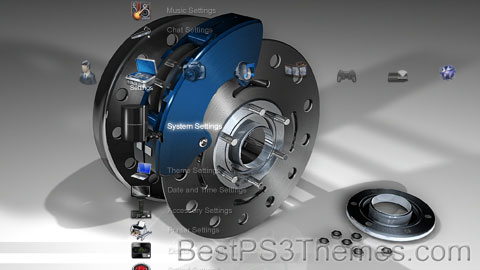
(1 background)
Copyright (c) 2007. Anoop Menon
p3textractor filename.p3t [destination path]Replace filename with the name of the p3t file, and replace [destination path] with the name of the folder you want the files to be extracted to. A destination path is not required. By default it will extract to extracted.filename.BloodSpillXXT – Shaiya – Light
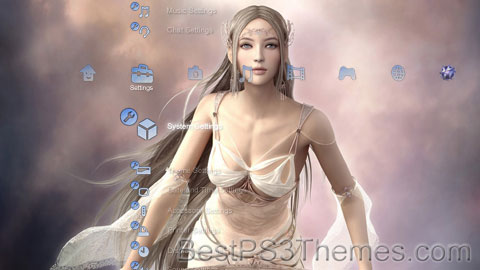
(6 backgrounds)
Copyright (c) 2007. Anoop Menon
p3textractor filename.p3t [destination path]Replace filename with the name of the p3t file, and replace [destination path] with the name of the folder you want the files to be extracted to. A destination path is not required. By default it will extract to extracted.filename.BloodSpillXXT – Shaiya – Darkness
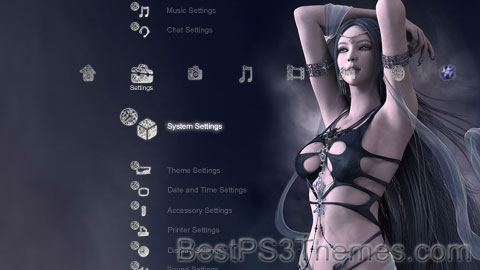
(6 backgrounds)
Copyright (c) 2007. Anoop Menon
p3textractor filename.p3t [destination path]Replace filename with the name of the p3t file, and replace [destination path] with the name of the folder you want the files to be extracted to. A destination path is not required. By default it will extract to extracted.filename.Take It Easy, Niko…
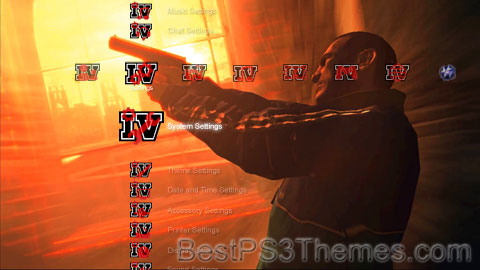
(3 backgrounds)
Copyright (c) 2007. Anoop Menon
p3textractor filename.p3t [destination path]Replace filename with the name of the p3t file, and replace [destination path] with the name of the folder you want the files to be extracted to. A destination path is not required. By default it will extract to extracted.filename.Tiger #3
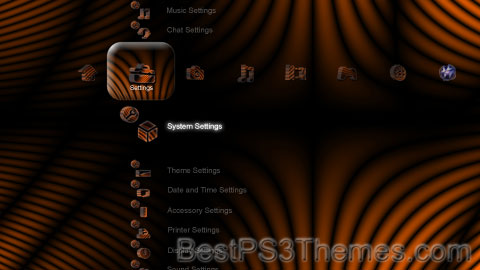
(1 background)
Tiger

A Bengal tigress in Kanha Tiger Reserve, India
Scientific classification ![]()
Domain:
Eukaryota
Kingdom:
Animalia
Phylum:
Chordata
Class:
Mammalia
Order:
Carnivora
Suborder:
Feliformia
Family:
Felidae
Subfamily:
Pantherinae
Genus:
Panthera
Species:
Binomial name
Panthera tigris
Subspecies
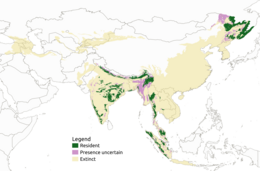
Tiger distribution as of 2022
Synonyms[3]
Etymology[edit]
Taxonomy[edit]
Subspecies[edit]
Population
Description
Image
Bengal tiger formerly P. t. tigris (Linnaeus, 1758)[2]
This population inhabits the Indian subcontinent.[17] The Bengal tiger has shorter fur than tigers further north,[8] with a light tawny to orange-red colouration,[8][18] and relatively long and narrow nostrils.[19]
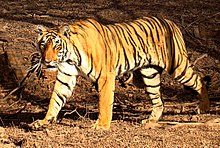
†Caspian tiger formerly P. t. virgata (Illiger, 1815)[20]
This population occurred from Turkey to around the Caspian Sea.[17] It had bright rusty-red fur with thin and closely spaced brownish stripes,[21] and a broad occipital bone.[11] Genetic analysis revealed that it was closely related to the Siberian tiger.[22] It has been extinct since the 1970s.[23]

Siberian tiger formerly P. t. altaica (Temminck, 1844)[24]
This population lives in the Russian Far East, Northeast China and possibly North Korea.[17] The Siberian tiger has long hair and dense fur.[24] Its ground colour varies widely from ochre-yellow in winter to more reddish and vibrant after moulting.[25] The skull is shorter and broader than the skulls of tigers further south.[19]

South China tiger formerly P. t. amoyensis (Hilzheimer, 1905)[26]
This tiger historically lived in south-central China.[17] The skulls of the five type specimens had shorter carnassials and molars than tigers from India, a smaller cranium, orbits set closer together and larger postorbital processes; skins were yellowish with rhombus-like stripes.[26] It has a unique mtDNA haplotype due to interbreeding with ancient tiger lineages.[12][27][28] It is extinct in the wild as there has not been a confirmed sighting since the 1970s,[1] and survives only in captivity.[15]
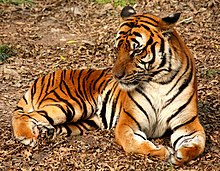
Indochinese tiger formerly P. t. corbetti (Mazák, 1968)[29]
This tiger population occurs on the Indochinese Peninsula.[17] Indochinese tiger specimens are smaller with smaller skulls than specimens from India and appear to have darker fur with slightly narrower stripes.[29][30]

Malayan tiger formerly P. t. jacksoni (Luo et al., 2004)[31]
The Malayan tiger was proposed as a distinct subspecies on the basis of mtDNA and micro-satellite sequences that differ from the Indochinese tiger.[31] It does not differ significantly in fur colour or skull size from Indochinese tigers.[30] There is no clear geographical barrier between tiger populations in northern Malaysia and southern Thailand.[1]

Population
Description
Image
†Javan tiger formerly P. t. sondaica (Temminck, 1944)[24]
This tiger was described based on an unspecified number of skins with short and smooth hair.[24] Tigers from Java were small compared to tigers of the Asian mainland, had relatively elongated skulls compared to the Sumatran tiger, and longer, thinner and more numerous stripes.[30] The Javan tiger is thought to have gone extinct by the 1980s.[23]

†Bali tiger formerly P. t. balica (Schwarz, 1912)[32]
This tiger occurred on Bali and had brighter fur and a smaller skull than the Javan tiger.[32][33] A typical feature of Bali tiger skulls is the narrow occipital bone, which is similar to the Javan tiger's skull.[34] The tiger went extinct in the 1940s.[23]
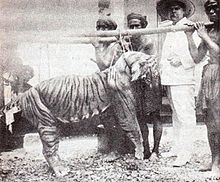
Sumatran tiger formerly P. t. sumatrae (Pocock, 1929)[35]
The type specimen from Sumatra had dark fur.[35] The Sumatran tiger has particularly long hair around the face,[17] thick body stripes,[30] and a broader and smaller nasal bone than other island tigers.[30][19]
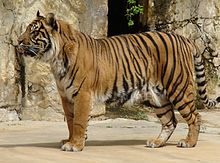
Evolution[edit]
Phylogeny of the Panthera based on nuclear DNA[36]
Chunky Metal
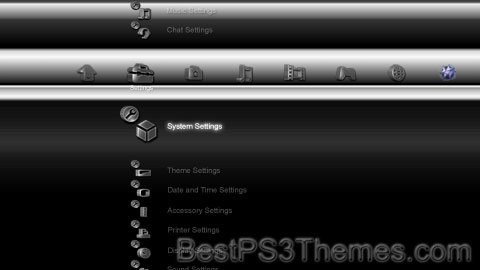
(3 backgrounds HD, 1 SD)
Copyright (c) 2007. Anoop Menon
p3textractor filename.p3t [destination path]Replace filename with the name of the p3t file, and replace [destination path] with the name of the folder you want the files to be extracted to. A destination path is not required. By default it will extract to extracted.filename.Final Fantasy VII #9
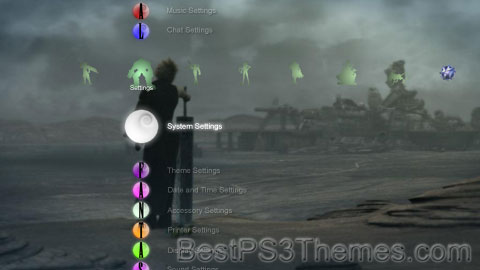
(12 backgrounds)
Final Fantasy VII 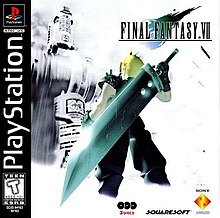
Developer(s) Square Publisher(s) Director(s) Yoshinori Kitase Producer(s) Hironobu Sakaguchi Programmer(s) Ken Narita Artist(s) Writer(s) Yoshinori Kitase
Kazushige NojimaComposer(s) Nobuo Uematsu Series Final Fantasy Platform(s) Release Genre(s) Role-playing Mode(s) Single-player Gameplay[edit]

Synopsis[edit]
Setting and characters[edit]
Plot[edit]
Development[edit]
Art design[edit]
Scenario[edit]
Jessica Simpson #2

(2 backgrounds)

Born
July 10, 1980Education J.J. Pearce High School
Texas Tech High SchoolOccupations Years active 1993–present Organization The Jessica Simpson Collection Spouses Children 3 Relatives Ashlee Simpson (sister) Awards Full list Musical career Genres Instrument(s) Vocals Labels Website jessicasimpson
Life and career[edit]
1980–1998: Childhood and career beginnings[edit]
1999–2001: Breakthrough with early musical releases[edit]

2002–2005: Marriage to Nick Lachey and heightened success[edit]

2006–2009: A Public Affair, other movies, and Do You Know[edit]

2010–present: Motherhood, second marriage, and focus on business ventures[edit]

BoM Resistance 2
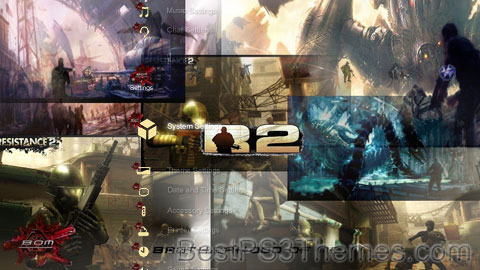
(1 background)
Copyright (c) 2007. Anoop Menon
p3textractor filename.p3t [destination path]Replace filename with the name of the p3t file, and replace [destination path] with the name of the folder you want the files to be extracted to. A destination path is not required. By default it will extract to extracted.filename.



